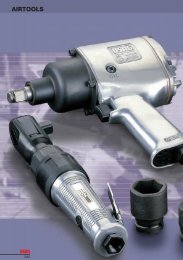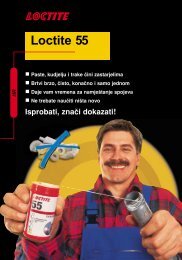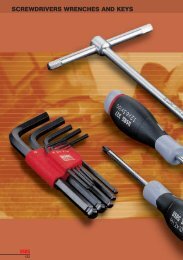Industrial seal self study guide - SKF.com
Industrial seal self study guide - SKF.com
Industrial seal self study guide - SKF.com
You also want an ePaper? Increase the reach of your titles
YUMPU automatically turns print PDFs into web optimized ePapers that Google loves.
Cut Seal Lip<br />
Ever-so-slight <strong>seal</strong> leakage is evidence that there may be a small nick<br />
or cut in the <strong>seal</strong>ing lip (fig. 9k).<br />
Causes<br />
It may have been caused by a burr on the keyway, spline or shaft end.<br />
Corrective Actions<br />
Follow these steps to correct and prevent cuts on the <strong>seal</strong> lip:<br />
• Use a deburring tool or emery cloth to remove any burrs. Use<br />
correct mounting tools to protect the <strong>seal</strong> lip from sharp edges. Be<br />
sure to tape the keyway or spline. Handle <strong>seal</strong>s carefully. Keep <strong>seal</strong>s<br />
packaged during storage or while in transit.<br />
A nicked <strong>seal</strong> lip also causes lip<br />
leakage (fig. 9k).<br />
Lube Breakdown<br />
Sludge or varnish-like deposits on the <strong>seal</strong> lip and/or shaft are<br />
symptoms of lube breakdown (fig. 9l).<br />
Causes<br />
Sometimes heat is high enough to break down the oil, but not enough<br />
to harden the lip. In this case, sludge accumulates and is deposited on<br />
the <strong>seal</strong> lip.<br />
Corrective Actions<br />
Reduce operating temperature if possible, or use a <strong>seal</strong> designed<br />
for high temperatures (fluoroelastomer type). Be sure to use proper<br />
lubricant for the <strong>seal</strong>. It also helps to change the oil regularly.<br />
Heat Checking<br />
Heat checking or cracking is another <strong>com</strong>mon <strong>seal</strong>ing problem.<br />
This may be evidenced by a hardened <strong>seal</strong> lip or fine cracks that show<br />
up in the <strong>seal</strong> lip surface (fig. 9m).<br />
Causes<br />
These problems with the <strong>seal</strong> may be caused by an operating<br />
temperature greater than the lip material maximum. Other<br />
reasons for heat cracking are excessive surface speeds or insufficient<br />
lubrication at the <strong>seal</strong> lip.<br />
Corrective Actions<br />
One possible solution is to reduce the temperature or select a <strong>seal</strong><br />
material with a higher temperature range. In the other cases, change<br />
the lip material to one that is <strong>com</strong>patible with the lube or provide<br />
proper lube for the <strong>seal</strong>. For high pressure applications, be sure to<br />
use a <strong>seal</strong> designed for that purpose, such as CRWA5.<br />
Sludge deposits on the <strong>seal</strong> lip<br />
indicate lube breakdown (fig. 9l).<br />
Fine cracks in the <strong>seal</strong> lip are<br />
visible signs of excess heat or<br />
pressure (fig. 9m).<br />
9<br />
83







